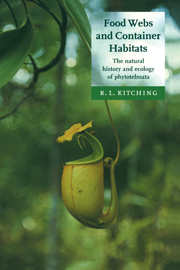Book contents
- Frontmatter
- Contents
- Preface
- 1 Introduction
- Part I The container flora, fauna and environment
- Part II Methods and theories
- 5 The construction and quantification of food webs
- 6 Processes structuring food webs
- Part III Patterns in phytotelm food webs
- Part IV Processes structuring food webs
- Part V Synthesis
- Annexe: The phytotelm bestiary
- References
- Index
5 - The construction and quantification of food webs
Drawing the webs
Published online by Cambridge University Press: 26 August 2009
- Frontmatter
- Contents
- Preface
- 1 Introduction
- Part I The container flora, fauna and environment
- Part II Methods and theories
- 5 The construction and quantification of food webs
- 6 Processes structuring food webs
- Part III Patterns in phytotelm food webs
- Part IV Processes structuring food webs
- Part V Synthesis
- Annexe: The phytotelm bestiary
- References
- Index
Summary
A food web in its simplest form is merely a diagrammatic or mathematical summary of the trophic interactions in a community: an indication of what eats what.
This having been said, it remains noteworthy how many different ways authors have chosen to represent what they perceived as this ‘simple’ concept. The purpose of this short chapter is to illustrate the different ways in which I have chosen to represent phytotelm food webs. I have found it appropriate to use a range of forms of representation of food webs to illustrate different points or test different hypotheses. To insist on a single standard is to misplace emphasis on method rather than question. Nevertheless it has not always been made abundantly clear in food-web descriptions what the ground rules of construction have been: and I have been as guilty of this misdemeanour as others. Accordingly I lay out here sets of rules for constructing webs that are used in ensuing chapters.
In addition the chapter introduces and defines a number of summarising statistics which may be extracted from food webs. Again I define only those quantities which I use subsequently: other authors have used other statistics. Parenthetically the chapter also introduces a food web from each class of phytotelmata as a tool for explaining web construction and the extraction of the statistics.
- Type
- Chapter
- Information
- Food Webs and Container HabitatsThe Natural History and Ecology of Phytotelmata, pp. 93 - 113Publisher: Cambridge University PressPrint publication year: 2000



